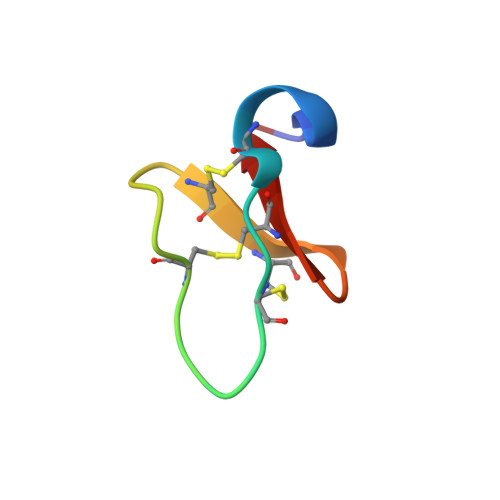A novel suite of cyclotides from Viola odorata: sequence variation and the implications for structure, function and stability
Ireland, D.C., Colgrave, M.L., Craik, D.J.(2006) Biochem J 400: 1-12
- PubMed: 16872274
- DOI: https://doi.org/10.1042/BJ20060627
- Primary Citation of Related Structures:
2GJ0 - PubMed Abstract:
Cyclotides are a fascinating family of plant-derived peptides characterized by their head-to-tail cyclized backbone and knotted arrangement of three disulfide bonds. This conserved structural architecture, termed the CCK (cyclic cystine knot), is responsible for their exceptional resistance to thermal, chemical and enzymatic degradation. Cyclotides have a variety of biological activities, but their insecticidal activities suggest that their primary function is in plant defence. In the present study, we determined the cyclotide content of the sweet violet Viola odorata, a member of the Violaceae family. We identified 30 cyclotides from the aerial parts and roots of this plant, 13 of which are novel sequences. The new sequences provide information about the natural diversity of cyclotides and the role of particular residues in defining structure and function. As many of the biological activities of cyclotides appear to be associated with membrane interactions, we used haemolytic activity as a marker of bioactivity for a selection of the new cyclotides. The new cyclotides were tested for their ability to resist proteolysis by a range of enzymes and, in common with other cyclotides, were completely resistant to trypsin, pepsin and thermolysin. The results show that while biological activity varies with the sequence, the proteolytic stability of the framework does not, and appears to be an inherent feature of the cyclotide framework. The structure of one of the new cyclotides, cycloviolacin O14, was determined and shown to contain the CCK motif. This study confirms that cyclotides may be regarded as a natural combinatorial template that displays a variety of peptide epitopes most likely targeted to a range of plant pests and pathogens.
Organizational Affiliation:
Institute for Molecular Bioscience and Australian Research Council Special Research Centre for Functional and Applied Genomics, The University of Queensland, Brisbane QLD 4072, Australia.














